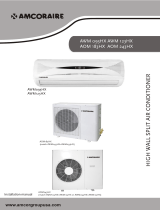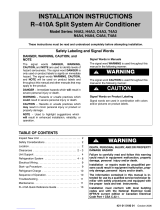
Product Specifications Sheets for recommended low-stage and
high-stage indoor airflow values.
Refer to indoor unit Installation Instructions to set the indoor
blower for the proper low-stage and high-stage airflow values.
NOTE: Optimal comfort, efficiency, and reliability will only be
achieved when the indoor airflow is properly set for both
low-stage and high-stage operation.
START-UP
UNIT OPERATION AND SAFETY HAZARD
Failure to follow this caution may result in minor personal
injury, equipment damage or improper operation.
To prevent compressor damage or personal injury,
observe the following:
• Do not overcharge system with refrigerant.
• Do not operate unit in a vacuum or at negative
pressure.
• Do not disable low pressure switch in scroll compressor
applications.
• Dome temperatures may be hot.
PERSONAL INJURY HAZARD
Failure to follow this caution may result in personal injury.
Wear safety glasses, protective clothing, and gloves
when handling refrigerant and observe the following:
• Front seating service valves are equipped with
Schrader valves.
ENVIRONMENTAL HAZARD
Failure to follow this caution may result in environmental
damage.
Federal regulations require that you do not vent refrigerant
to the atmosphere. Recover during system repair or final
unit disposal.
Follow these steps to properly start up the system:
1. After system is evacuated, fully open liquid and vapor
service valves.
2. Unit is shipped with valve stem(s) front seated (closed) and
caps installed.
Replace stem caps after system is opened to refrigerant
flow. Replace caps finger-tight and tighten with wrench an
additional 1/12 turn
3. Close electrical disconnects to energize system.
4. Set room thermostat at desired temperature. Be sure set
point is below indoor ambient temperature.
5. Set room thermostat to COOL and fan control to ON or
AUTO mode, as desired. Operate unit for 15 minutes.
Check system refrigerant charge.
Check Charge
Two-stage equipment must be charged in high stage compressor
operation only.
Factory charge amount and desired subcooling are shown on unit
rating plate. Charging method is shown on information plate
inside unit. To properly check or adjust charge, conditions must
421 01 1702 04
be favorable for subcooling charging. Favorable conditions exist
when the outdoor temperature is between 70°F and 100°F
(21.11 °C and 37.78°C), and the indoor temperature is between
70°F and 80°F (21.11°C and 26.67°C). Follow the procedure
below:
Unit is factory charged for 15ft (4.57 m) of lineset. Adjust charge
by adding or removing 0.6 oz/ft of 3/8 liquid line above or below
15ft (4.57 m) respectively.
For standard refrigerant line lengths (80 ft/24.38 m or less), allow
system to operate in cooling mode at least 15 minutes. When
operating with the Observer Wall Control in communicating mode,
make sure that indoor airflow is set to the final operating selection
(Eft 325, Elf 350, Comfort, Maximum) during charging. If
conditions are favorable, check system charge by subcooling
method. If any adjustment is necessary, adjust charge slowly and
allow system to operate for 15 minutes to stabilize before
declaring a properly charged system.
If the indoor temperature is above 80°F (26.67°C), and the
outdoor temperature is in the favorable range, adjust system
charge by weight based on line length and allow the indoor
temperature to drop to 80°F (26.67°C) before attempting to check
system charge by subcooling method as described above.
If the indoor temperature is below 70°F (21.11 °C), or the outdoor
temperature is not in the favorable range, adjust charge for line
set length above or below 15ft (4.57 m) only. Charge level should
then be appropriate for the system to achieve rated capacity. The
charge level could then be checked at another time when the
both indoor and outdoor temperatures are in a more favorable
range.
NOTE: The Observer Wall Control has a staging timer, to override
the staging timer for charging in high-stage create at least a 5
degree difference between room and set point temperatures and
hold the "Cool To" button for 10 seconds on the thermostat home
screen.
NOTE: If line length is beyond 80 ft (24.38 m) or greater than 20
ft (6.10 m) vertical separation, See Long Line Applications Guideline
for special charging requirements.
SYSTEM FUNCTIONS AND SEQUENCE OF
OPERATION
The *CA9 and *CA7 models utilize either an Observer
Communicating Wall Control or a 2-stage cooling thermostat. With
a call for first stage cooling, the outdoor fan and low-stage
compressor are energized. If low-stage cannot satisfy cooling
demand, high-stage is energized by the second stage of the
indoor thermostat. After second stage is satisfied, the unit returns
to low-stage operation until first stage is satisfied or until second
stage is required again. When both first stage and second stage
cooling are satisfied, the compressor will shut off. When a 2-stage
unit is operating at low-stage, system vapor (suction) pressure will
be higher than a standard single-stage system or high-stage
operation. When the outdoor ambient is more than 100°F
(37.8°C), the outdoor fan will continue to run for one minute after
compressor shuts off, this reduces pressure differential for easier
starting in the next cycle.
Communication and Status Function Lights
Green communications (COMM) Light (Only with
Observer Communicating Wall Control)
A green LED (COMM light) on the outdoor board indicates
successful communication with the other system products. The
green LED will remain OFF until communications is established.
Once a valid command is received, the green LED will turn ON
continuously. If no communication is received within 2 minutes,
the LED will be turned OFF until the next valid communication.
Specifications subject to change without notice. 7

















